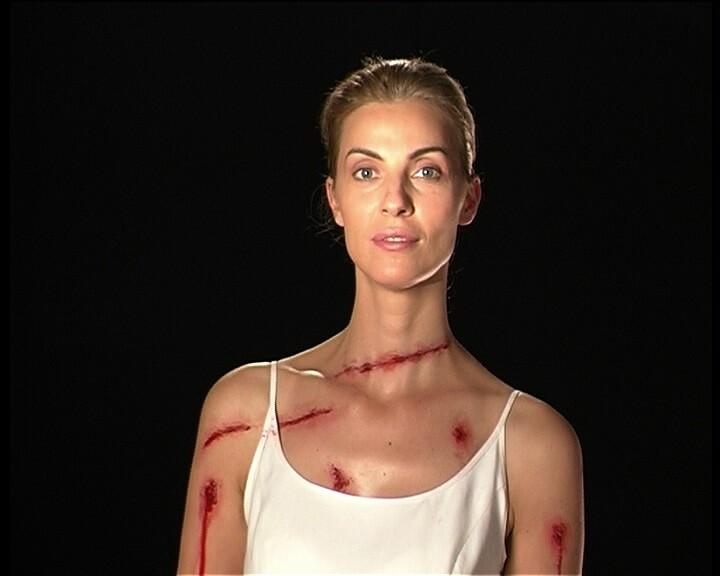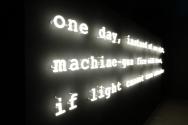Milica Tomić: On Love Afterwards
/6
Taking its title from a poem by the Yugoslav-Montenegrin poet and anti-fascist Radovan Zogović (1907–1986), this exhibition opens with an eponymous 2003 video that features interviews with four World War II Yugoslav partisans about their motivations for joining the people’s liberation and anti-fascist struggle. Positioned opposite is a work featuring a quotation from a poem written in commemoration of a comrade by the Serbian surrealist and revolutionary socialist Oskar Davičo: “One Day, Instead of Night, Machine-Gun Fire Will Burst if Light Cannot Come Otherwise” (2025). This LED signage recalls a photographically documented 2009 intervention by the artist in Belgrade where she, acting as an urban guerrilla, traced forgotten anti-fascist sites carrying an AK-47 and a plastic bag.
Working across media, Tomić examines political and economic violence as well as social amnesia, exploring the inseparable link between intimacy and politics. Her practice, which often involves collective-based work, expands both the methods and the scope of contemporary art. She co-founded the art-theoretical collective Grupa Spomenik (2002–2014), which sought to create conditions for art and theory to engage with genocide and ongoing war, as well as the investigative art collective Four Faces of Omarska (2014–), which explores memorial strategies from the perspective of those excluded from public memory and history.
In seeking a counter-language via which to confront violence and injustice, poetry—like love—serves as a catalyst for a new political imagination. It becomes both a tool and a medium for illuminating the nuanced entanglement of collective resistance and individual agency from Second World War anti-fascism to postwar modernism, the Non-Aligned Movement, and the ethnonationalism that fueled the wars in the former Yugoslavia. Through radical performances including staged conversations, manifestos, public montage series, and early video works like “Aktenzeichen XY… Ungelöst – Reconstruction Of The Crime” (1996/97) and “I am Milica Tomić” (1999), she traces the interplay of geopolitical realities and broader intellectual and political frameworks.
A key challenge of this exhibition lies precisely in conveying the performative, longue durée nature of Tomić’s practice, which transcends disciplinary boundaries, as well as in retaining the vibrancy of her public actions and non-linear montage series, which stand out for their collaborative process of open editing through which she continually juxtaposes and interrogates the complex interrelations of traumatic histories, exploitation, and ongoing violence.
The exhibition’s curation in dialogue with the architecture situates visitors within a dynamic chronology, illuminating interconnections between overlapping processes, projects, and archival research stations—thereby often enabling the simultaneous experience of multiple works. An anchor here is Tomić’s new sculpture, crafted from an experimental material that was hardened by way of organic spore growth in collaboration with scientists from the Graz University of Technology. This multilayered central work amplifies the physical, theoretical, and metaphorical significance of the knot, evoking the Borromean Knot—a Lacanian model that interconnects the “real,” the “symbolic,” and the “imaginary.”
This materially driven object, entitled “Is There Anything in This World You Would Be Ready to Give Your Life For?” and situated at the intersection of sculptural practice, textile logic, and the living agency of a mycelium, was realized in collaboration with the 13th Berlin Biennale for Contemporary Art and presented concurrently in Graz and Berlin. The work extends and reframes the central inquiry posed in Tomić’s 1999 video “Portrait of My Mother,” which documents a series of intimate dialogues with her mother, Marija Milutinović, recorded in the immediate aftermath of the NATO bombing.
After leaving a successful acting career to pursue a spiritual path, Milutinović became a renowned textile artist specializing in macramé, a form of textile created through knotting. By the early 1980s, however, she had destroyed all of her artworks and devoted herself entirely to Orthodox Christianity.
The video is presented in conjunction with the installation “Knotworks” (2025), which centers on an absent object—a large-scale tapestry by Milutinović—manifested solely by way of its photographic representation. With this mediated image, Tomić addresses a constellation of concerns including the dynamics of agency, the negotiation of individual subjectivity within systemic structures, the construction of value, and the delineation between the personal and the public. At the same time, it also confronts acts of destruction and the irrevocable loss of material presence.
Milica Tomić’s practice engages deeply in the development of counterstrategies of image-making with a distinctly critical and political edge. In her ongoing project “Container. Index of War” (2004–), which examines a specific strategic mode of reconstruction following a massacre in Northern Afghanistan in 2001, she turns her attention to the production of the “non-existent war image.”
For the attendee who takes pause to simply stand still in the exhibition space, the surrounding installation of videos stands as a silent reminder of the institutional negotiations that determine how artistic practice might be read as provocation in the context of real-time violence.
Lívia Páldi
Lívia Páldi is a curator and art historian currently based in Budapest and working for the BHM Kiscell Museum – Municipal Gallery. Her most recent project “OCTOBER – from silence to resistance” focuses on the entanglement of the political with the personal and intimate, paying particular attention to women’s perspectives.
November 2025
Working across media, Tomić examines political and economic violence as well as social amnesia, exploring the inseparable link between intimacy and politics. Her practice, which often involves collective-based work, expands both the methods and the scope of contemporary art. She co-founded the art-theoretical collective Grupa Spomenik (2002–2014), which sought to create conditions for art and theory to engage with genocide and ongoing war, as well as the investigative art collective Four Faces of Omarska (2014–), which explores memorial strategies from the perspective of those excluded from public memory and history.
In seeking a counter-language via which to confront violence and injustice, poetry—like love—serves as a catalyst for a new political imagination. It becomes both a tool and a medium for illuminating the nuanced entanglement of collective resistance and individual agency from Second World War anti-fascism to postwar modernism, the Non-Aligned Movement, and the ethnonationalism that fueled the wars in the former Yugoslavia. Through radical performances including staged conversations, manifestos, public montage series, and early video works like “Aktenzeichen XY… Ungelöst – Reconstruction Of The Crime” (1996/97) and “I am Milica Tomić” (1999), she traces the interplay of geopolitical realities and broader intellectual and political frameworks.
A key challenge of this exhibition lies precisely in conveying the performative, longue durée nature of Tomić’s practice, which transcends disciplinary boundaries, as well as in retaining the vibrancy of her public actions and non-linear montage series, which stand out for their collaborative process of open editing through which she continually juxtaposes and interrogates the complex interrelations of traumatic histories, exploitation, and ongoing violence.
The exhibition’s curation in dialogue with the architecture situates visitors within a dynamic chronology, illuminating interconnections between overlapping processes, projects, and archival research stations—thereby often enabling the simultaneous experience of multiple works. An anchor here is Tomić’s new sculpture, crafted from an experimental material that was hardened by way of organic spore growth in collaboration with scientists from the Graz University of Technology. This multilayered central work amplifies the physical, theoretical, and metaphorical significance of the knot, evoking the Borromean Knot—a Lacanian model that interconnects the “real,” the “symbolic,” and the “imaginary.”
This materially driven object, entitled “Is There Anything in This World You Would Be Ready to Give Your Life For?” and situated at the intersection of sculptural practice, textile logic, and the living agency of a mycelium, was realized in collaboration with the 13th Berlin Biennale for Contemporary Art and presented concurrently in Graz and Berlin. The work extends and reframes the central inquiry posed in Tomić’s 1999 video “Portrait of My Mother,” which documents a series of intimate dialogues with her mother, Marija Milutinović, recorded in the immediate aftermath of the NATO bombing.
After leaving a successful acting career to pursue a spiritual path, Milutinović became a renowned textile artist specializing in macramé, a form of textile created through knotting. By the early 1980s, however, she had destroyed all of her artworks and devoted herself entirely to Orthodox Christianity.
The video is presented in conjunction with the installation “Knotworks” (2025), which centers on an absent object—a large-scale tapestry by Milutinović—manifested solely by way of its photographic representation. With this mediated image, Tomić addresses a constellation of concerns including the dynamics of agency, the negotiation of individual subjectivity within systemic structures, the construction of value, and the delineation between the personal and the public. At the same time, it also confronts acts of destruction and the irrevocable loss of material presence.
Milica Tomić’s practice engages deeply in the development of counterstrategies of image-making with a distinctly critical and political edge. In her ongoing project “Container. Index of War” (2004–), which examines a specific strategic mode of reconstruction following a massacre in Northern Afghanistan in 2001, she turns her attention to the production of the “non-existent war image.”
For the attendee who takes pause to simply stand still in the exhibition space, the surrounding installation of videos stands as a silent reminder of the institutional negotiations that determine how artistic practice might be read as provocation in the context of real-time violence.
Lívia Páldi
Lívia Páldi is a curator and art historian currently based in Budapest and working for the BHM Kiscell Museum – Municipal Gallery. Her most recent project “OCTOBER – from silence to resistance” focuses on the entanglement of the political with the personal and intimate, paying particular attention to women’s perspectives.
November 2025












